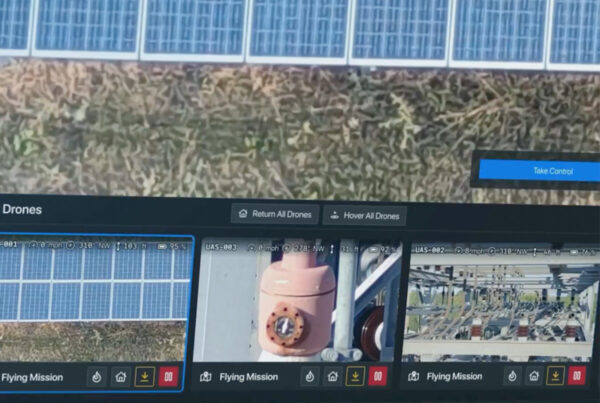
It was easy to anticipate the damage that could be caused by Hurricane Fiona as it barrelled up the East Coast of North America in late September. But the reality of its destruction was still a shock. In Puerto Rico, the entire island was left without power for weeks; floodwaters wiped out roads and other critical infrastructure. A similar scenario played out in Atlantic Canada, where 95% of customers in Prince Edward Island lost power and entire homes were swept away by huge waves, torrential rain and wind gusts of over 100 miles per hour.
Though Fiona wasn’t the most destructive hurricane in recent years, it came at a time when public utilities are facing new challenges and hard choices, and new opportunities.
Weather events are becoming more extreme and more unpredictable, requiring more resilient networks and a plan for dealing with critical but aging infrastructure. At the same time, there’s the additional need to decarbonize—and hopefully mitigate the impact of a changing climate by doing so. These challenges can be met with new digital technologies and new business models, raising the prospect of additional economic growth.
The year ahead may seem daunting, but it’s also exciting: utilities have never before faced such monumental change. Here’s what they need to consider in 2023.
Resiliency
When a record-breaking ice storm rolled through the St. Lawrence Valley in 1998, parts of Quebec were coated in over three feet of ice, causing power lines to snap and transmission towers to collapse. Millions of people were left in the dark and cold—some for as long as a month. But the storm was met by an intensive rebuilding effort that has left Quebec’s power grid more durable than ever.
Today, it isn’t just physical infrastructure that needs to be made resilient. In the face of ever more frequent weather events—not to mention the risk of other threats such as cyberattacks or terrorism—utilities need every aspect of their organization to be able to resist these pressures and rapidly bounce back every time. That’s especially true as infrastructure becomes older because as networks age the impact of any negative event will be even more acute.
Data is key to resilience. That’s where new technology comes in, specifically decision analytics technology such as Asset Investment Planning (AIP) solutions. Rather than scrambling to react each time an unexpected event occurs, utilities can use capital planning and asset investment planning software to compare different futures through data-driven insights.
AIP ; it isn’t a box to be ticked. Instead, it’s an important step in being able to create resilient networks. It helps with decision-making processes and prioritization planning, allowing utilities to input different metrics in order to simulate and forecast problems so they can map out solutions. How much time will it take to recover from a flood, for instance? A mix of historical data, future trends and investment scenarios can paint a picture of the impact of different strategies.
This will ultimately help utilities update their critical infrastructure based on their mission, goals and vision, helping them plan their operating expenses properly as they make important changes. It’s a way to build better and stronger, and to be able to keep promises made to stakeholders.
Decarbonization
Moving away from fossil fuels isn’t the future; it’s the present. Utilities around the world are grappling with the urgent need to move towards renewable sources of energy. They’re being given a helping hand in many countries. In the U.S., the federal Inflation Reduction Act has set aside $370 billion over the next 10 years to support home electrification, solar and wind power, electric vehicles and more.
But even with that support, change can be bewildering for any organization. First, there’s the timeline: when an entire sector needs to be transformed, every day counts. Then there are resources. Large-scale infrastructure projects are difficult enough because of supply chain issues and a lack of human capital, let alone what it takes to start something entirely new. And, of course, cost is always a huge factor. In Canada, it is expected to cost C$3 trillion over two decades to totally rebuild the energy sector.
Once again, this is where the ability to compare different futures by using data-driven insights is crucial. Let’s say a utility has 10,000 generators, 30% of which are carbon-intensive. What’s the best course of action? Should the generators be replaced all in one go, or balanced with other projects? The right capital planning and asset investment planning software can analyze the utility’s resources and lay bare the costs and opportunities of each possible course action.
Digitalization
Digitalization often is framed in terms of the relationship between utilities and their customers. For example, smart electricity meters provide real-time data that gives power companies the chance to better analyze and anticipate demand, while giving their customers a chance to adapt their own habits in a way that saves them money.
But digitalization also has enormous potential for the way utilities operate and plan for the future. Going forward, utilities need to think about the digitalization of their own human expertise. It’s particularly important to record all of the organizational knowledge held by individuals, which isn’t necessarily shared or documented internally in order to create a digital business twin of this knowledge.
With capital planning and asset investment planning software, those digital business twins form the building blocks for drag-and-drop decision tree modeling that doesn’t require any programming skills. That means teams across an organization can collaborate on projects to create what-if scenarios based on many different variables, such as changing priorities and unplanned events, while having the insights to make decisions straight away. Engineers can input technical asset data, modelers can simulate different scenarios, finance teams can view the cost impacts, risk teams can add different forms of risks based on different factors, and the resulting dashboards can be shared with an executive who is making the final decision.
Decentralization
Distributed resources are great as part of a resilient grid; they have fewer points of weakness and greater redundancy options.
But there are implications that need to be anticipated. With rapid improvements in technology, there has been a rise in the number of micro-grids and distributed energy resources (DERs) emerging. What’s the best course of action for utilities when these systems are supplementing, and in some cases replacing, traditional systems of energy production and distribution?
These decentralized options aren’t going to disappear. So, the only choice is to adapt and mitigate any future challenges with robust planning and grid modeling.
When you have a digitized network, you can forecast the impacts of DERs to see how they affect your bottom line, your networks, even your individual assets at any point in the future. If you can better forecast network consumption, you’ll know where to invest.
If a utility is looking to rebuild a station but there is currently 30% less consumption in that area because homeowners have installed solar panels, that has ongoing impacts. When a grid serves fewer people, prices tend to go up; so fewer people want to use the grid as their main source of energy. What happens when these people want to sell their excess energy back to the suppliers? What happens when the sun sets and all those people suddenly come back on to the grid at the same time and there is a surge? Will there be sections of infrastructure that degrade quicker or slower due to these changes in consumption?
All these hypothetical scenarios can be mapped out using capital planning software, giving utilities insight into where they should focus their energy and investments.














